Dragonchess

The
Dragonchess 3D gameboard:
- Air (upper board)
- Land (middle board)
- Subterranean world (lower board)
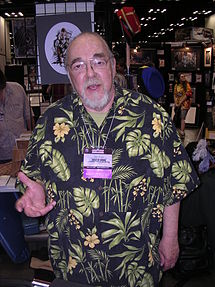
Gary Gygax
Dragonchess is a three-dimensional fantasy chess variant created by Gary Gygax, co-creator of the famed role-playing game Dungeons & Dragons. The game was introduced in 1985 in issue No. 100 of Dragon Magazine.
The Dragonchess gameboard consists of three vertically stacked 12x8 levels. The upper level (blue and white) represents the air, the middle level (green and amber) represents the land, and the lower level (red and brown) is the subterranean world (Gygax 1985:34).
The Dragonchess game pieces (42 per player) are an ensemble of characters and monsters inspired or derived from fantasy settings in Dungeons & Dragons. Intricate inter- and intra-level game piece capabilities are defined. As in chess, the game is won by delivering checkmate to the enemy king.
Upper board
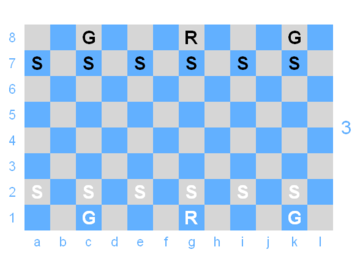
Upper board starting position
 The Sky Board
The Sky Board, by Zac Dortch
Sylph (S)
- On level 3:
- can move one step diagonally forward, or capture one step straight forward;
- can capture on the square directly below on level 2.
- On level 2:
- can move to the square directly above on level 3, or to one of the player's six Sylph starting squares.
Griffon (G)
- On level 3:
- can move and capture by jumping in the following pattern: two steps diagonally followed by one step orthogonally outward;
- can move and capture one step triagonally to level 2.
- On level 2:
- can move and capture one step diagonally;
- can move and capture one step triagonally to level 3.
Dragon (R)
- Bound to level 3:
- can move and capture any number of unobstructed steps diagonally, or one step orthogonally;
- can capture remotely (without leaving level 3) on the square directly below on level 2, or on any square orthogonally adjacent to that square.
Middle board
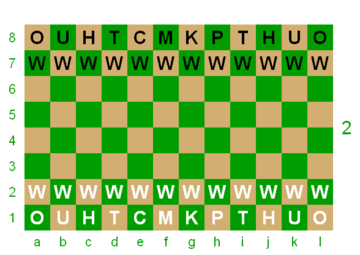
Middle board starting position
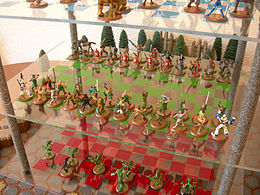 The Ground Board
The Ground Board, by Zac Dortch
Warrior (W)
- Bound to level 2:
- can move one step straight forward, or capture one step diagonally forward;
- promotes to Hero when reaching the 8th rank.
Oliphant (O)
- Bound to level 2:
- can move and capture any number of unobstructed steps orthogonally.
Unicorn (U)
- Bound to level 2:
- can move and capture the same as a chess knight.
Hero (H)
- On level 2:
- can move and capture one or two unblockable steps diagonally;
- can move and capture one step triagonally to levels 1 or 3.
- On levels 1 and 3:
- can move and capture one step triagonally to the same square on level 2 the Hero previously left.
Thief (T)
- Bound to level 2:
- can move and capture any number of unobstructed steps diagonally.
Cleric (C)
- On any level:
- can move and capture one step in any direction;
- can move and capture to the square directly above or directly below on an adjacent level.
Mage (M)
- On level 2:
- can move and capture any number of unobstructed steps diagonally or orthogonally.
- On levels 1 and 3:
- can move one step orthogonally.
- On any level:
- can move and capture one or two steps directly above or directly below to one of the other levels.
King (K)
- On level 2:
- can move and capture one step in any direction;
- can move and capture to the square directly below on level 1 or directly above on level 3.
- On levels 1 and 3:
- can move to (only) the same square on level 2 the King previously left.
Paladin (P)
- On level 2:
- can move and capture as a chess king+knight;
- can move to levels 1 or 3 using an (unblockable) knight-like move: one level up or down followed by two steps orthogonally.
- On levels 1 and 3:
- can move and capture one step in any direction;
- can move to the other levels using an (unblockable) knight-like move: one level up or down followed by two steps orthogonally, or two levels up or down followed by one step orthogonally.
Lower board
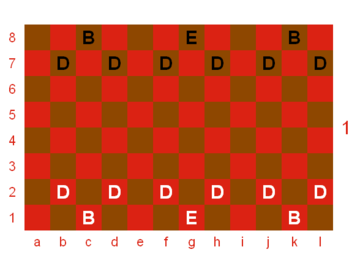
Lower board starting position
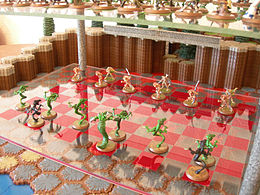 The Underground Board
The Underground Board, by Zac Dortch
Dwarf (D)
- On level 1:
- can move one step straight forward or sideways, or capture one step diagonally forward;
- can capture on the square directly above on level 2.
- On level 2:
- can move one step straight forward or sideways, or capture one step diagonally forward;
- can move to the square directly below on level 1.
Basilisk (B)
- Bound to level 1:
- can move and capture one step diagonally forward or straight forward, or move one step straight backward;
- automatically freezes (immobilizes) an enemy piece on the square directly above on level 2, whether the Basilisk moves to the space below or the enemy moves to the space above, and until the Basilisk moves away or is captured.
Elemental (E)
- On level 1:
- can move and capture one or two steps orthogonally;
- can move one step diagonally;
- can capture in the following pattern: one step orthogonally followed by the square directly above on level 2.
- On level 2:
- can move and capture in the following pattern: the square directly below on level 1 followed by one step orthogonally.
Move notation
Recording moves is done the same as in algebraic notation for chess, extended to a 12x8 board, with the addition of a numeric prefix (1, 2, or 3) in front of each square coordinate to identify the level. So for example, White's Elemental starts on square 1g1 (level 1, square g1); Black's King starts on 2g8; and so on.
Read more:
COMMENTS
















 Upper board starting position
Upper board starting position The Sky Board, by Zac Dortch
The Sky Board, by Zac Dortch Middle board starting position
Middle board starting position The Ground Board, by Zac Dortch
The Ground Board, by Zac Dortch Lower board starting position
Lower board starting position The Underground Board, by Zac Dortch
The Underground Board, by Zac Dortch